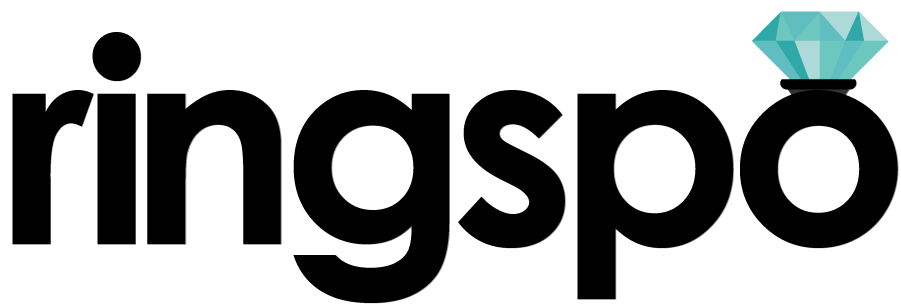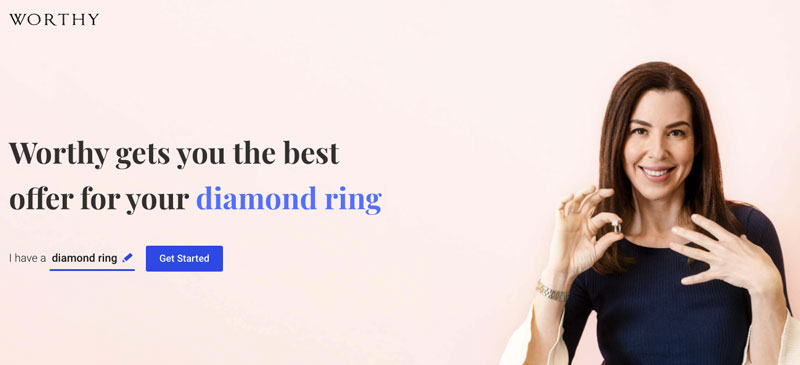Emerald Value: Understand How to Get The Most When Selling Emerald Jewelry
Plus: The Guide to Emerald Buyers and Where To Sell

By Alastair Smith · Updated: June 13th 2023
Whether it’s a cherished heirloom, a recent addition to your collection or something that you’re currently considering moving on, you may find yourself wondering: How much is my emerald actually worth?
That’s the question we’ll help you answer in this article.

Ringspo is reader supported
Ringspo is reader-supported, which means we may receive a commission if you click a link to a retailer & subsequently make a purchase.
We feature links to several retailers to help readers find the one that is the best fit for them. Find out more about how Ringspo works here.
Three things to know if you are looking to sell your emerald jewelry
- Selling an emerald is like selling a second-hand car – you won’t get the ‘list price’ ie. the appraisal value
- The color if the most important in deciding the value of your stone – everything else is secondary, including carat weight
- Finding the right buyer is key to get the most money possible. We recommend Worthy as they will get your emerald jewelry out in front of as many potential buyers as possible, which can increase you sale price.
Why Your Receipt or Appraisal Isn’t the Best Indicator of What Your Emerald is Actually Worth:
First-off, we’re going to get this slightly awkward bit out of the way.
While you may have the original purchase receipt or an appraisal for your emerald jewelry that has a price or a valuation on it, they almost certainly don’t reflect the current market value of your emerald if you were trying to sell it.
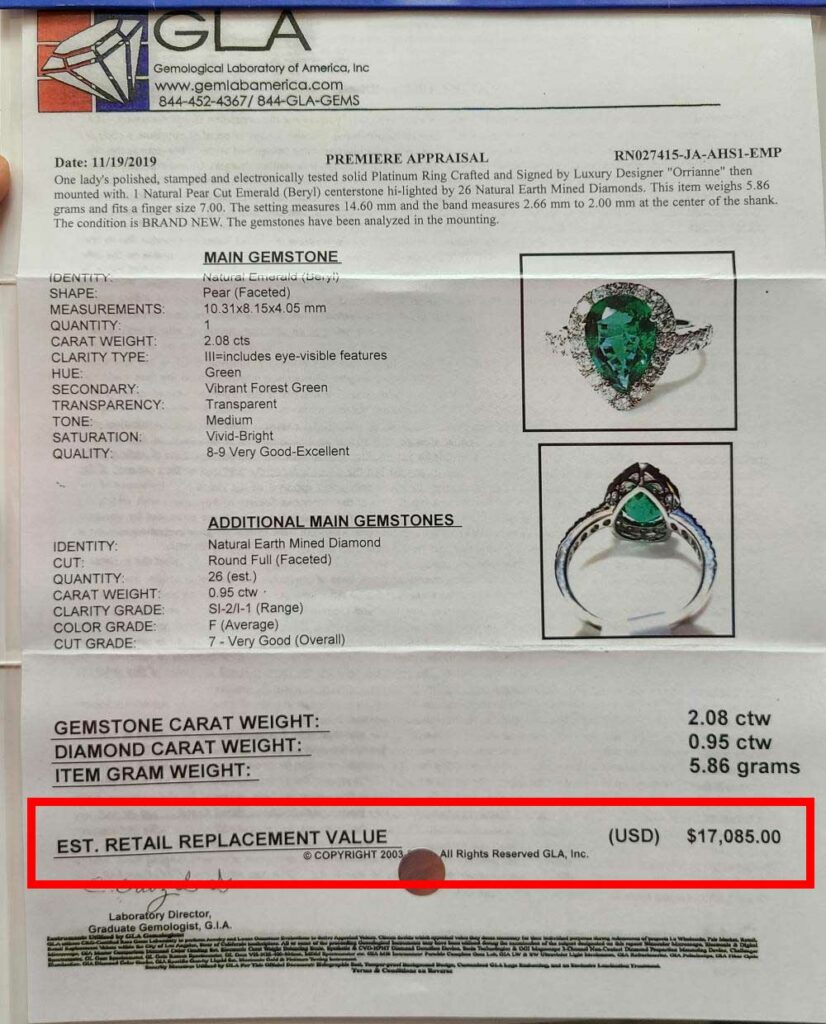
The reason for this is that anyone who is going to buy your emerald will be looking to sell it for a price that is appropriate for a pre-owned piece of jewelry. Plus, they need to cover their own costs and build in some profit margin for themselves.
What appraisals or a receipt are useful for:
Both a purchase receipt and an appraisal should contain essential information about your emerald such as its carat weight, color, clarity, cut, origin, and any treatments it has undergone.
They should also detail the type and quality of the metal and any other gemstones included in the jewelry.
This is all essential information that you’ll need when selling your emerald as it will allow potential buyers to understand what you have..
Factors That Affect Emerald Value
When we talk about the value of an emerald, we’re really talking about how much someone would be willing to pay for it.
For instance, a 1-carat emerald can cost anywhere from $100 to over $10,000, depending on its quality.

Before we explore the valuation process, let’s take a moment to understand the key factors that influence an emerald’s value.
These factors include color, clarity, cut, carat weight, origin, and treatment. Each element plays a vital role in determining the overall worth of your emerald.
Color and its effect on emerald value:
Emeralds are prized for their mesmerizing green hues. To assess an emerald’s color, you need to consider three key aspects: hue, saturation, and tone.
- Hue: The hue refers to the primary and secondary colors observed in the emerald. The most desirable hue is a pure green with no noticeable yellow or blue undertones. However, secondary hues can impact the value positively or negatively, depending on their intensity and balance. For instance, a subtle bluish-green hue can enhance the value, while a strong yellowish-green hue may diminish it.
- Saturation: Saturation refers to the intensity or vividness of the emerald’s color. The most valuable emeralds exhibit a high saturation, which gives them a vibrant and lively appearance. On the other hand, emeralds with low saturation may appear dull or washed out, leading to a decrease in value.
- Tone: The tone represents the lightness or darkness of the emerald’s color. Ideally, emeralds with a medium to medium-dark tone are preferred, as they allow the saturation to shine through. If the tone is too light or too dark, it can negatively impact the emerald’s value and overall appeal.
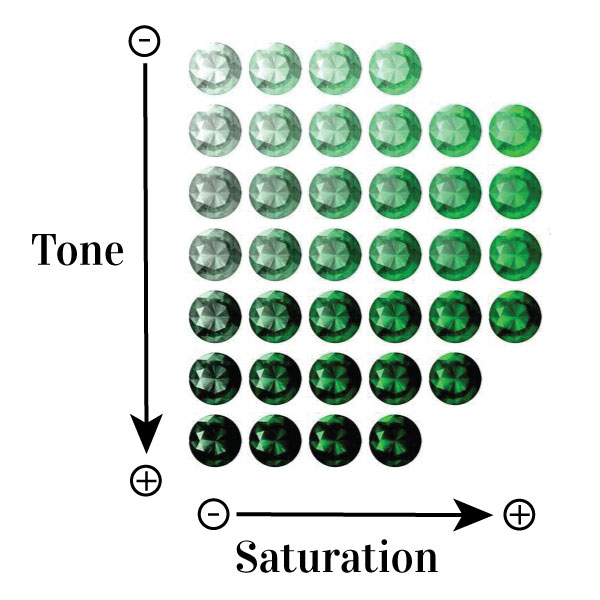
To help you understand the range of emerald colors and their corresponding values, here are a few examples.
- A vivid green Colombian emerald, free from significant inclusions and with excellent saturation and tone, could be valued at around $5,000 per carat or more.
- A Zambian emerald with a rich green color, good saturation, and minimal inclusions may have a value of approximately $2,000 to $3,000 per carat.
- Brazilian emeralds, often exhibiting a slightly yellowish-green hue, can offer a more affordable option. Prices for Brazilian emeralds can range from $500 to $1,500 per carat, depending on the overall quality.
These are approximate price ranges and can vary based on market conditions, specific gem characteristics, and other factors. It’s crucial to consult with a reputable gemologist or jeweler to obtain an accurate valuation for your emerald.
By understanding the different hues, saturations, and tones of emeralds, you can begin to assess the color quality of your own emerald and gain insights into its potential value.
Emerald Clarity:
Clarity refers to the presence or absence of inclusions (internal flaws) and blemishes (external flaws) within your emerald.
Unlike diamonds, which are known for their exceptional clarity, emeralds almost have some inclusions to some degree, and they’re considered part of their natural beauty and character.
Inclusions can take various forms, such as cracks, bubbles, crystals, or other foreign materials that affect the transparency and brilliance of the emerald. Blemishes, on the other hand, can appear as scratches, chips, nicks, or pits on the surface of the gem.
While it is expected for emeralds to have inclusions, their impact on value depends on several factors. Large, numerous, visible, or structurally damaging inclusions can decrease an emerald’s value. Inclusions that reach the surface may also make the emerald more prone to breaking or chipping, affecting its durability.

Emeralds can be categorized into three types based on their level of inclusion:
- Type 1: These emeralds are generally free of inclusions or have an extremely low presence of inclusions. They are exceptionally rare and are typically associated with laboratory-grown emeralds. However, even in lab-grown emeralds, some minor inclusions may be observable under magnification.
- Type 2: These emeralds typically have inclusions, although they are not severe or overly prominent. Inclusions are commonly observed in this type but do not significantly impact the gem’s beauty or transparency.
- Type 3: These emeralds are characterized by a high likelihood of inclusions, and many of them can be severe or highly visible. Type 3 emeralds almost always exhibit a noticeable presence of inclusions, which may have a significant impact on their overall appearance and transparency.
Cut and its effect on Emerald Price
Cut refers to the shape, proportions, symmetry, and polish of the gemstone.
While emeralds can be cut into various shapes, including round, oval, pear, marquise, cushion, square, rectangular, or triangular, the most common and popular shape for emeralds is the rectangular step cut, also known as the emerald cut.
This cut showcases the emerald’s color and clarity exceptionally well.

Unlike diamonds, emeralds aren’t usually graded for cut quality by an independent organisation like GIA.
Nevertheless, different emeralds at the same carat weight can look very different sizes due to differences in surface area when viewed from the top, which can affect their desirability and their value.
Carat weight and its effect on Emerald value
Carat weight is a crucial factor in determining the value of an emerald. It refers to the measure of how much the emerald weighs, not necessarily how big it appears. One carat is equivalent to 0.2 grams or 0.007 ounces. The carat weight of an emerald significantly impacts its value because larger emeralds are generally more rare and desirable than smaller ones.
One thing to know is that emerald prices increase exponentially with carat weight. This means that a 2-carat emerald will not simply be twice as expensive as a 1-carat emerald but significantly more valuable.
However, it’s important to consider that emerald prices vary depending on the quality of other factors such as color, clarity, and cut. In some cases, a smaller emerald of higher quality may hold greater value than a larger emerald with lower quality.
How Origin affects the value of an Emerald
The origin of an emerald refers to the geographic location where it was mined. Certain origins are renowned for producing emeralds of exceptional quality and are highly sought after in the market.

The origin of an emerald can impact its value due to its influence on the gemstone’s color, clarity, and rarity:
- Colombian Emeralds: Colombian emeralds are esteemed for their vivid green hue with a slight bluish tint. They are highly valued for their exceptional color and transparency.
- Brazilian Emeralds: Brazilian emeralds often exhibit a slightly yellowish-green hue. While they may not possess the same vibrant color as Colombian emeralds, they still offer unique beauty and can provide a more budget-friendly option.
- Zambian Emeralds: Zambian emeralds are renowned for their deep green hue with a slight grayish tint. They are admired for their rich color and are often sought after for their unique appearance.
- Ethiopian Emeralds: Ethiopian emeralds are relatively new to the market but have gained attention for their striking green color and transparency.
Emerald Treatments:
Treatment refers to the process of enhancing or altering the appearance or durability of an emerald and the type of treatment used can significantly impact the gemstone’s value.
One of the most common treatments is oiling, wherein oils, resins, or waxes are applied to fill tiny fissures in the stone’s surface, thereby improving the clarity and overall appearance. However, oiling is a temporary solution and needs to be reapplied over time, so it can somewhat lower the value of the stone due to its impermanence.
Emerald before treatment:
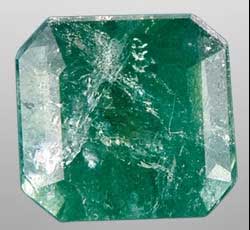
Emerald after treatment:
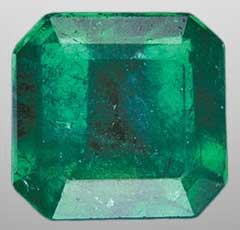
Another popular treatment is the use of green-tinted oil or resin, which serves to enhance an emerald’s color and clarity simultaneously. This method is less accepted in the market because it alters the natural color of the gemstone, and as such, it can significantly decrease the emerald’s value.
A more invasive, yet permanent treatment is the use of polymer resins, like Opticon, which are used to fill fractures and improve an emerald’s durability. This treatment tends to maintain the gemstone’s natural color better than green-tinted oil. However, because it is more difficult to detect and heavily alters the natural state of the gemstone, this treatment is viewed skeptically in the market and can considerably reduce an emerald’s value.
Heat treatment is also used on emeralds but is less common due to the risk of damaging the gemstone. This process enhances the color by reducing the presence of some inclusions or yellow hues. Gemstones that undergo this treatment might achieve a higher price if the color improvement is significant and the process does not damage the gemstone.
Overall, untreated emeralds are the most prized in the market, as their natural state represents rarity and authenticity. The type and level of treatment, transparency about such treatments, and the final appearance of the emerald are all factors that greatly influence the gemstone’s final market value.
Certification
Certification refers to the documentation provided by an independent and reputable gemological laboratory that verifies the authenticity and quality of the emerald. A certified emerald comes with an official report that outlines its characteristics, including the 4Cs, origin, and any treatments applied.
Certification helps identify any treatments or enhancements applied to the emerald. It ensures transparency in the gemstone’s history, allowing informed decisions for buyers and sellers, adding credibility to the transaction and offering peace of mind.
Not all emeralds will be accompanied by a certificate, but those that are often have a price premium attached to them due to the additional peace of mind that they give the buyer or seller.
1 Carat Emerald Value:
The value of a 1 carat emerald will be influenced by all the factors we’ve discussed so far – color, clarity, cut, and origin, and more. The value of a 1 carat emerald can range from $300 to $10,000 or more, depending on these factors.
Some examples of different 1 carat emerald values:
- A 1 carat emerald with a light green hue, low saturation, light tone, moderate inclusions, poor cut, and unknown origin may have a value in the range of $300 to $500. These emeralds may exhibit more affordable prices due to their lower quality characteristics.
- A 1 carat emerald with a medium green hue, medium saturation, medium tone, slight inclusions, good cut, and Brazilian origin may have a value in the range of $1,000 to $2,000. These emeralds offer a balance between quality and affordability.
- A 1 carat emerald with a vivid green hue, high saturation, medium-dark tone, very slight inclusions, excellent cut, and Colombian origin may have a value in the range of $5,000 to $10,000 or more. These emeralds exhibit exceptional color and quality, making them highly sought after and commanding higher prices.
These are just examples, and actual values may vary based on market demand and supply, the type and extent of any treatment applied to the emerald, and the certification and appraisal of the gemstone.
2 Carat Emerald Value:
Similar to 1 carat emeralds, the value of a 2 carat emerald is determined by the quality of factors such as color, clarity, cut, and origin. These elements collectively contribute to the gemstone’s overall desirability and, subsequently, its value. The value of a 2 carat emerald can range from $600 to $20,000 or more:
- A 2 carat emerald with a light green hue, low saturation, light tone, moderate inclusions, poor cut, and unknown origin may have a value in the range of $600 to $1,000. These emeralds, with their lower quality characteristics, typically offer more affordable pricing.
- A 2 carat emerald with a medium green hue, medium saturation, medium tone, slight inclusions, good cut, and Brazilian origin may have a value in the range of $2,000 to $4,000. These emeralds strike a balance between quality and affordability, making them an attractive option for buyers.
- A 2 carat emerald with a vivid green hue, high saturation, medium-dark tone, very slight inclusions, excellent cut, and Colombian origin may have a value in the range of $10,000 to $20,000 or more. These emeralds, exhibiting exceptional color and quality, are highly sought after and command premium prices.
Again, these are just examples – to obtain an accurate valuation of your specific 2 carat emerald, it is recommended to consult with a reputable gemologist or jeweler.
How to Sell Your Emerald For the Best Price
When you’re selling emerald jewelry, it can be tempting to go for a quick, easy sale. However, doing do can mean that you receive significantly less than you should.
If you’re in a hurry to sell and simply Google ’emerald buyers near me’ and then choose the first on the list, it’s likely that you will receive significantly less for your diamond than you should.

Selling Your Emerald on Online Marketplaces (e.g Facebook Marketplace, Craigslist, eBay):
Online marketplaces such as Facebook Marketplace, Craigslist, and eBay provide platforms for individuals to buy and sell various items, including gemstones like emerald.
Selling an emerald through these online marketplaces offers certain advantages and considerations specific to each platform.
- Broad Audience - these platforms have millions of users, increasing the chances of finding a potential buyer
- You have the flexibility to set your own price, upload photos, and write descriptions about your emerald.
- The process of listing an item for sale is typically simple and can be done from the comfort of your home
- Online platforms can attract fraudulent buyers or scams. It's important to be cautious and use secure payment methods.
- Potential buyers may be skeptical about the quality and authenticity of the emerald as they can't inspect it in person before buying
- Without sufficient understanding of the gemstone market, you might undervalue or overvalue your emerald making it harder to sell
- Possibility of security risks or fraud
Selling Your Emerald to an Auction House
Auction houses are establishments that facilitate the sale of gemstones and jewelry to the highest bidder in a public or private setting. Selling your emerald through an auction house can offer prestige, access to a knowledgeable audience, and the potential for competitive bidding that could drive up the price.
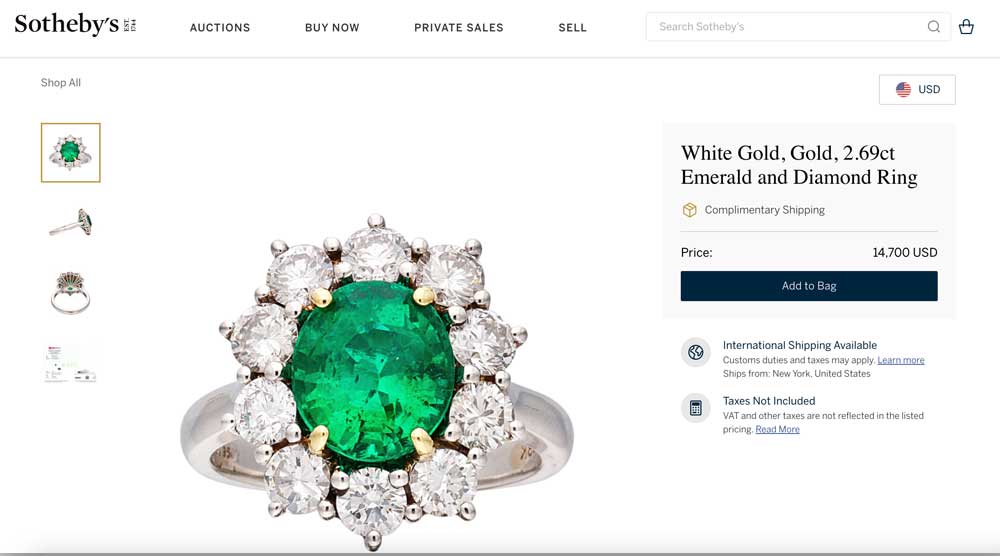
However, it’s crucial to consider factors such as fees or commissions charged by the auction house, appraisal or consignment costs, the unpredictability of results, and potential waiting times or limited opportunities for auctions.
- Prestige and access to an audience knowledgeable about emeralds
- Potential for competitive bidding and higher prices
- Possibility of driving up the price through bidding
- Fees or commissions charged by the auction house
- Appraisal or consignment costs
- Unpredictability of results
- Waiting times or limited auction opportunities
Selling Your Emerald To A Jeweler
Selling your emerald to a jeweler can provide access to their knowledge, experience, and trustworthiness. They can offer insights into the market value of your emerald and guide you through the selling process.
However, it’s important to be aware that jewelers may offer lower prices due to their overhead costs or inventory needs, have limited demand or availability for certain items, offer subjective opinions, or face potential conflicts of interest if they also serve as appraisers.
- Access to professionals who are likely to be knowledgeable about emeralds
- Trustworthiness and guidance throughout the selling process
- Market insights and expertise
- Lower prices due to jeweler's overhead costs or inventory needs
- May be limited demand for emeralds
- Subjective opinions
- Potential conflicts of interest
Selling Your Emerald Using An Online Platform
Online platforms are websites or apps that connect sellers and buyers of gemstones and jewelry. Selling your emerald through online platforms can offer convenience, speed, and exposure to a large and global market.
These platforms allow you to reach a wide range of potential buyers. However, it’s important to be aware of potential drawbacks such as fees or commissions charged by the platform, shipping or insurance costs, security or fraud risks, and the possibility of facing competition that may impact prices.
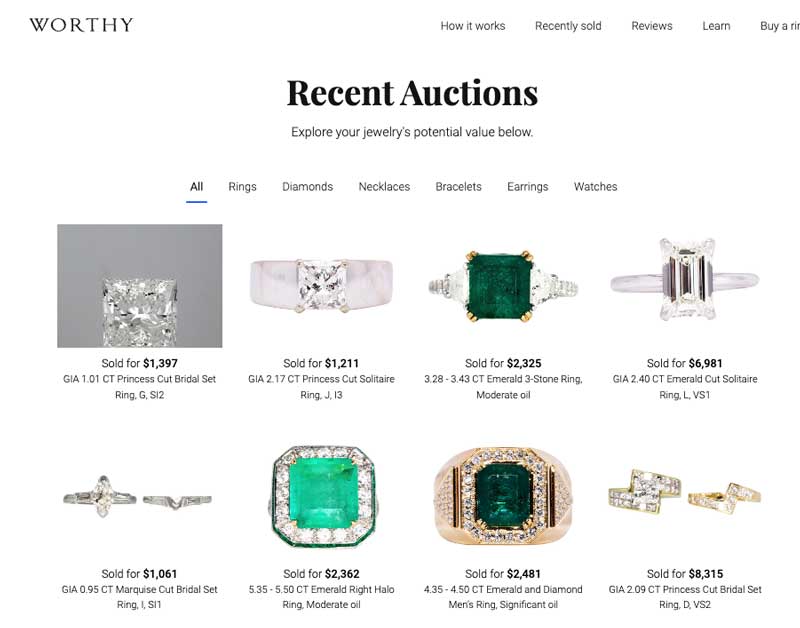
- Convenient and accessible platform with global market reach
- Ability to reach a wide range of potential buyers for your emerald
- Quick and efficient selling process
- Fees of commissions charged by the platform
- Additional costs for shipping and insurance
- Possibility of security risks or fraud
Selling Your Emerald To A Pawn Shop
Pawn shops are businesses that offer loans or cash in exchange for gemstones and jewelry as collateral.
Selling your emerald to a pawn shop can provide quickness, simplicity, and discretion. However, it’s important to be mindful of potential downsides such as lower prices offered due to the shop’s profit margin or lack of expertise, high interest rates or fees if you intend to redeem your item later, limited negotiation options, limited selection, or potential legal or ethical concerns.
- Quick and simple selling process
- Discretion in the transaction
- Potentially faster access to cash
- Lower prices due to the pawn shop's profit margin or lack of expertise with emeralds
- High interest rates or fees if you intend to redeem your item
- Limited negotiation options
Summing Up: Our Recommendation on Where to Sell Your Emerald
Before selling, conduct thorough research and compare prices from different sources. Have your emerald appraised and certified by a reputable gemologist or laboratory. This step verifies the authenticity and quality of your gemstone, providing confidence to potential buyers.
Select the selling option that aligns with your goals, preferences, and situation. Carefully weigh the pros and cons of each option and negotiate for the best deal possible.
Be realistic and flexible in your expectations and demands. Understand that the market value of your emerald may not match your sentimental value or personal preference.
Worthy.com: The Best Way To Sell An Emerald For Most People
Worthy is an auction site that gets your emerald jewelry out in front of hundreds of jewelry buyers to bid on.
This scale means that higher sales prices can be achieved, but Worthy’s commissions do need to be take into account when calculating how much you will actually receive into your pocket.
And again, if you haven’t checked it out, the ‘recent auctions‘ page is definitely worth checking out.
